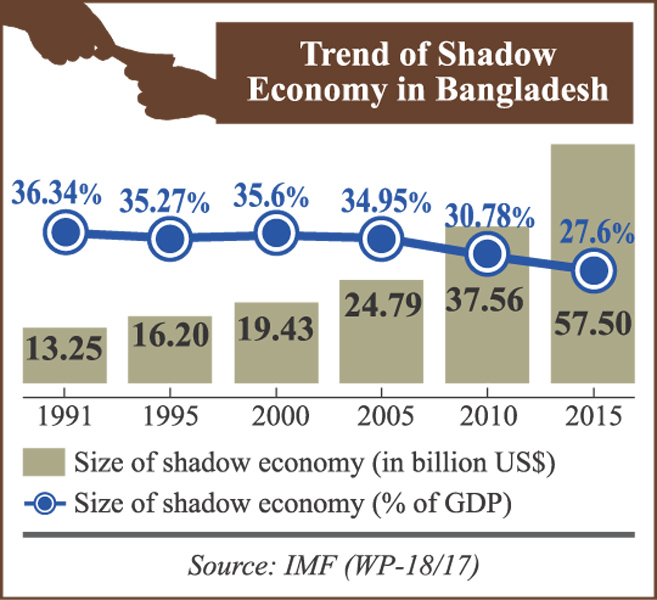The ratio of the shadow economy in Bangladesh in terms of the Gross Domestic Product (GDP) has been declining for more than one decade.
Shadow economy, also known as the black economy, means all economic activities, which are hidden from official authorities for monetary, regulatory, and institutional reasons.
The ratio came down to 27.60 per cent of the country's annual GDP in 2015, which was 36.65 per cent in 2003.
 A working paper of the International Monetary Fund (IMF) spotted the trend.
A working paper of the International Monetary Fund (IMF) spotted the trend.
The paper also showed Bangladesh is listed among the 31 countries where the average ratio of shadow economy is more than 30 per cent, as estimated on the basis of Predictive Mean Matching Method (PMM).
The paper, jointly prepared by Leandro Medina and Dr Friedrich Schneider, focused on the existing and new estimation methods of the shadow economy.
It also presented the size of the shadow economy for 158 countries all over the world between 1991 and 2015.
The working paper, titled 'Shadow Economies Around the World: What Did We Learn Over the Last 20 Years?', showed that average size of the shadow economy of the 158 countries over 1991 to 2015 is 31.9 per cent.
The largest ones are Zimbabwe with 60.6 per cent and Bolivia with 62.3 per cent of GDP.
The lowest ones are Austria with 8.9 per cent and Switzerland with 7.2 per cent.
"For our study, the shadow economy reflects mostly legal economic and productive activities that, if recorded, would contribute to national GDP, therefore the definition of the shadow economy in our study tries to avoid illegal or criminal activities, do-it-yourself, or other household activities," the authors said in the paper.
According to the estimation of the paper, shadow economy as a percentage of the GDP was 36.34 per cent in 1991 which slightly came down to 35.60 per cent in 2000. In the decade, the average ratio stood at 36.04 per cent of the GDP of Bangladesh.
In the later decade, the average ratio modestly came down to 33.83 per cent, according to the estimation.
The FE estimates the value of shadow economy in Bangladesh by multiplying the ratio with the annual GDP data provided by the IMF in current price. The IMF converted the GDP into national currency to US dollars using annual average market exchange rate.
The FE estimate showed that though the ratio of shadow economy has been declining, it is increasing in value terms.
The value of shadow economy was $13.25 billion in 1999, which increased to $19.43 billion in 2000. It increased further to $37.56 billion in 2010 and jumped to $57.49 billion in 2015.
In an e-mailed message, Dr Friedrich Schneider confirmed that the estimate is correct.
He also said that government corruption and regulation and the tax burden are the main drivers of shadow economy.
When asked whether it is possible to bring the shadow economy near to zero or below 10 per cent of GDP, the economist replied in the negative.
"No," he said in a written reply to the emailed question. "I think this is not possible for your country (Bangladesh), especially as corruption is still very high and will not come down in the next 10 years!"
Dr Zaid Bakht, a former research director of the Bangladesh Institute of Development Studies (BIDS), noted that the presence of shadow economy in Bangladesh is always a reality.
"The main source of the shadow economy is generation of unearned income like rent-seeking, bribe, commissions and extortions," he said while talking to FE on Friday.
"Again there are incomes legally earned but not declared to the tax authority are also come here."
Dr Bakht also said capital flight in the form of under and over-invoicing is also taking place but these are not a matter of big concern.
"The trade mis-invoicing is always there," he added.
"Now the more alarming is overseas investments by a few Bangladeshi businessmen. It should be strictly monitored."
The outflows of foreign direct investment (FDI) from Bangladesh jumped by three times in a year and stood at $170 million in 2017, according to the central bank statistics.
Dr Bakht, now the chairman of Agrani Bank, was of the view that there was also a practice of perking money anonymously or in the names of others, which sometime turned into black money.
"But if the money is deposited in the banks, no matter who is the actual owner, it is in the banking system and so in the formal circulation," he added.
© 2024 - All Rights with The Financial Express
